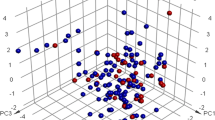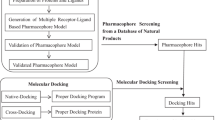Abstract
In this work, selectivity mechanism of APP-IP inhibitor (β-amyloid precursor protein-derived inhibitory peptide) over matrix metalloproteinases (MMPs including MMP-2, MMP-7, MMP-9 and MMP-14) was investigated by molecular modeling methods. Among MMPs, MMP-2 is the most favorable one for APP-IP interacting based on our calculations. The predicted binding affinities can give a good explanation of the activity difference of inhibitor APP-IP. In Comparison with MMP-2/APP-IP complex, the side chain of Tyr214MMP-7 makes the binding pocket so shallow that the whole side chain of Tyr3APP-IP can not be fully embraced, thus unfavorable for the N-terminal of APP-IP binding to MMP-7. The poor selectivity of APP-IP toward MMP-9 is mainly related with the decrease of interaction between the APP-IP C-terminal and MMP-9 due to the bulky side chains of Pro193 and Gln199, which is in agreement with experiment. The mutations at residues P193A and Q199G of MMP-9 alternate the binding pattern of the C-terminal of APP-IP by forming two new hydrogen bonds and hydrophobic interactions with MMP-9. The mutants favor the binding affinity of MMP-9 largely. For MMP-14/APP-IP, the large steric effect of Phe204MMP-14 and the weak contributions of the polar residues Asn231MMP-14 and Thr190MMP-14 could explain why MMP-14 is non-selective for APP-IP interacting. Here, the molecular modeling methods were successfully employed to explore the selective inhibitor of MMPs, and our work gives valuable information for future rational design of selective peptide inhibitors toward individual MMP.












Similar content being viewed by others
References
Hooper NM (1996) Zinc metalloproteases in health and disease. Taylor, Francis
Docherty AJP, O’Connell J, Crabbe T, Angal S, Murphy G (1992) The matrix metalloproteinases and their natural inhibitors: prospects for treating degenerative tissue diseases. Trends Biotechnol 10:200–207
Matrisian LM (1992) The matrix-degrading metalloproteinases. BioEssays 14(7):455–463
Stetler-Stevenson WG, Aznavoorian S, Liotta LA (1993) Tumor cell interactions with the extracellular matrix during invasion and metastasis. Annu Rev Cell Biol 9(1):541–573
Liotta LA (1986) Tumor invasion and metastases—role of the extracellular matrix: Rhoads memorial award lecture. Cancer Res 46(1):1–7
Collier IE, Wilhelm SM, Eisen AZ, Marmer BL, Grant GA, Seltzer JL, Kronberger A, He CS, Bauer EA, Goldberg GI (1988) H-Ras oncogene-transformed human bronchial epithelial cells (TBE-1) secrete a single metalloprotease capable of degrading basement membrane collagen. J Biol Chem 263(14):6579–6587
Wilhelm SM, Collier IE, Marmer BL, Eisen AZ, Grant GA, Goldberg GI (1989) SV40-transformed human lung fibroblasts secrete a 92-kDa type IV collagenase which is identical to that secreted by normal human macrophages. J Biol Chem 264(29):17213–17221
Van Wart HE, Birkedal-Hansen H (1990) The cysteine switch: a principle of regulation of metalloproteinase activity with potential applicability to the entire matrix metalloproteinase gene family. Proc Natl Acad Sci 87(14):5578–5582
Becker JW, Marcy AI, Rokosz LL, Axel MG, Burbaum JJ, Fitzgerald PMD, Cameron PM, Esser CK, Hagmann WK, Hermes JD, Springer JP (1995) Stromelysin-1: three-dimensional structure of the inhibited catalytic domain and of the C-truncated proenzyme. Protein Sci 4(10):1966–1976
Bode W, Gomis-Rüth F-X, Stöckler W (1993) Astacins, serralysins, snake venom and matrix metalloproteinases exhibit identical zinc-binding environments (HEXXHXXGXXH and Met-turn) and topologies and should be grouped into a common family, the ‘metzincins’. FEBS Lett 331(1–2):134–140
Gomis-Rüth FX, Gohlke U, Betz M, Knäuper V, Murphy G, López-Otín C, Bode W (1996) The helping hand of collagenase-3 (MMP-13): 2.7 Å crystal structure of its C-terminal haemopexin-like domain. J Mol Biol 264(3):556–566
Brew K, Dinakarpandian D, Nagase H (2000) Tissue inhibitors of metalloproteinases: evolution, structure and function. Biochim Biophys Acta 1477(1–2):267–283
Amour A, Slocombe PM, Webster A, Butler M, Knight CG, Smith BJ, Stephens PE, Shelley C, Hutton M, Knauper V, Docherty AJ, Murphy G (1998) TNF-alpha converting enzyme (TACE) is inhibited by TIMP-3. FEBS Lett 435(1):39–44
Amour A, Knight CG, Webster A, Slocombe PM, Stephens PE, Knäuper V, Docherty AJP, Murphy G (2000) The in vitro activity of ADAM-10 is inhibited by TIMP-1 and TIMP-3. FEBS Lett 473(3):275–279
Kashiwagi M, Tortorella M, Nagase H, Brew K (2001) TIMP-3 is a potent inhibitor of aggrecanase 1 (ADAM-TS4) and aggrecanase 2 (ADAM-TS5). J Biol Chem 276(16):12501–12504
Betz M, Huxley P, Davies SJ, Mushtaq Y, Pieper M, Tschesche H, Bode W, Gomis-Ruth FX (1997) 1.8-A crystal structure of the catalytic domain of human neutrophil collagenase (matrix metalloproteinase-8) complexed with a peptidomimetic hydroxamate primed-side inhibitor with a distinct selectivity profile. Eur J Biochem 247(1):356–363
Brandstetter H, Grams F, Glitz D, Lang A, Huber R, Bode W, Krell HW, Engh RA (2001) 1.8-A crystal structure of a matrix metalloproteinase 8-barbiturate inhibitor complex reveals a previously unobserved mechanism for collagenase substrate recognition. J Biol Chem 276(20):17405–17412
Jia MC, Schwartz MA, Sang QA (2000) Suppression of human microvascular endothelial cell invasion and morphogenesis with synthetic matrixin inhibitors. Targeting angiogenesis with MMP inhibitors. Adv Exp Med Biol 476:181–194
Finzel BC, Baldwin ET, Bryant GL Jr, Hess GF, Wilks JW, Trepod CM, Mott JE, Marshall VP, Petzold GL, Poorman RA, O’Sullivan TJ, Schostarez HJ, Mitchell MA (1998) Structural characterizations of nonpeptidic thiadiazole inhibitors of matrix metalloproteinases reveal the basis for stromelysin selectivity. Protein Sci 7(10):2118–2126
Higashi S, Miyazaki K (2003) Identification of a region of beta-amyloid precursor protein essential for its gelatinase A inhibitory activity. J Biol Chem 278(16):14020–14028
Higashi S, Miyazaki K (2008) Identification of amino acid residues of the matrix metalloproteinase-2 essential for its selective inhibition by beta-amyloid precursor protein-derived inhibitor. J Biol Chem 283(15):10068–10078
Hashimoto H, Takeuchi T, Komatsu K, Miyazaki K, Sato M, Higashi S (2011) Structural basis for matrix metalloproteinase-2 (MMP-2)-selective inhibitory action of β-amyloid precursor protein-derived inhibitor. J Biol Chem 286(38):33236–33243
Gohlke H, Case DA (2004) Converging free energy estimates: MM-PB(GB)SA studies on the protein–protein complex Ras-Raf. J Comput Chem 25(2):238–250
Hou T, McLaughlin W, Lu B, Chen K, Wang W (2005) Prediction of binding affinities between the human amphiphysin-1 SH3 domain and its peptide ligands using homology modeling, molecular dynamics and molecular field analysis. J Proteome Res 5(1):32–43
Hou T, Zhang W, Case DA, Wang W (2008) Characterization of domain–peptide interaction interface: a case study on the amphiphysin-1 SH3 domain. J Mol Biol 376(4):1201–1214
Fang L, Zhang H, Cui W, Ji M (2008) Studies of the mechanism of selectivity of protein tyrosine phosphatase 1B (PTP1B) bidentate inhibitors using molecular dynamics simulations and free energy calculations. J Chem Inf Model 48(10):2030–2041
Larkin MA, Blackshields G, Brown NP, Chenna R, McGettigan PA, McWilliam H, Valentin F, Wallace IM, Wilm A, Lopez R, Thompson JD, Gibson TJ, Higgins DG (2007) Clustal W and Clustal X version 2.0. Bioinformatics 23(21):2947–2948
Berman HM, Westbrook J, Feng Z, Gilliland G, Bhat TN, Weissig H, Shindyalov IN, Bourne PE (2000) The protein data bank. Nucleic Acids Res 28(1):235–242
Browner MF, Smith WW, Castelhano AL (1995) Crystal structures of matrilysin-inhibitor complexes. Biochemistry 34(20):6602–6610
Rowsell S, Hawtin P, Minshull CA, Jepson H, Brockbank SM, Barratt DG, Slater AM, McPheat WL, Waterson D, Henney AM, Pauptit RA (2002) Crystal structure of human MMP9 in complex with a reverse hydroxamate inhibitor. J Mol Biol 319(1):173–181
Fernandez-Catalan C, Bode W, Huber R, Turk D, Calvete JJ, Lichte A, Tschesche H, Maskos K (1998) Crystal structure of the complex formed by the membrane type 1-matrix metalloproteinase with the tissue inhibitor of metalloproteinases-2, the soluble progelatinase A receptor. EMBO J 17(17):5238–5248
Jorgensen WL, Chandrasekhar J, Madura JD, Impey RW, Klein ML (1983) Comparison of simple potential functions for simulating liquid water. J Chem Phys 79(2):926–935
Case DA, Cheatham TE, Darden T, Gohlke H, Luo R, Merz KM Jr, Onufriev A, Simmerling C, Wang B, Woods RJ (2005) The Amber biomolecular simulation programs. J Comput Chem 26(16):1668–1688
Duan Y, Wu C, Chowdhury S, Lee MC, Xiong G, Zhang W, Yang R, Cieplak P, Luo R, Lee T, Caldwell J, Wang J, Kollman P (2003) A point-charge force field for molecular mechanics simulations of proteins based on condensed-phase quantum mechanical calculations. J Comput Chem 24(16):1999–2012
Stote RH, Karplus M (1995) Zinc binding in proteins and solution: a simple but accurate nonbonded representation. Proteins Struct Funct Bioinform 23(1):12–31
Ryckaert J-P, Ciccotti G, Berendsen HJC (1977) Numerical integration of the cartesian equations of motion of a system with constraints: molecular dynamics of n-alkanes. J Comput Phys 23(3):327–341
Darden T, York D, Pedersen L (1993) Particle mesh Ewald: an N [center-dot] log(N) method for Ewald sums in large systems. J Chem Phys 98(12):10089–10092
Kollman PA, Massova I, Reyes C, Kuhn B, Huo S, Chong L, Lee M, Lee T, Duan Y, Wang W, Donini O, Cieplak P, Srinivasan J, Case DA, Cheatham TE (2000) Calculating structures and free energies of complex molecules: combining molecular mechanics and continuum models. Acc Chem Res 33(12):889–897
Tsui V, Case DA (2000) Theory and applications of the generalized Born solvation model in macromolecular simulations. Biopolymers 56(4):275–291
Weiser J, Shenkin PS, Still WC (1999) Approximate atomic surfaces from linear combinations of pairwise overlaps (LCPO). J Comput Chem 20(2):217–230
Gohlke H, Kiel C, Case DA (2003) Insights into protein–protein binding by binding free energy calculation and free energy decomposition for the Ras–Raf and Ras–RalGDS complexes. J Mol Biol 330(4):891–913
Onufriev A, Bashford D, Case DA (2004) Exploring protein native states and large-scale conformational changes with a modified generalized born model. Proteins Struct Funct Bioinform 55(2):383–394
Delano WL (2002) The PyMOL molecular graphics system on World Wide Web http://www.pymol.org
Acknowledgments
We gratefully acknowledge the National Natural Science Foundation of China (No. 21173264) and the Foundation of Knowledge Innovative Engineering of Chinese Academy of Sciences (No. ZNWH-2011-011) for supporting this work.
Author information
Authors and Affiliations
Corresponding authors
Electronic supplementary material
Below is the link to the electronic supplementary material.
Rights and permissions
About this article
Cite this article
Geng, L., Gao, J., Cui, W. et al. Computational insights into the selectivity mechanism of APP-IP over matrix metalloproteinases. J Comput Aided Mol Des 26, 1327–1342 (2012). https://doi.org/10.1007/s10822-012-9617-3
Received:
Accepted:
Published:
Issue Date:
DOI: https://doi.org/10.1007/s10822-012-9617-3




